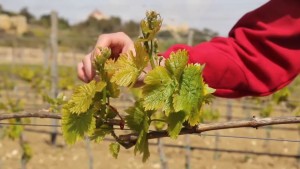Winter Drought in Maltese Vineyards

The vines’ growing season in Delicata’s vineyards is well underway.
As a wine enthusiast, you might have been speculating about the possible consequences of what has been recorded as the driest winter spell in Malta in the last 50 years on this year’s grape harvest and the yet to come 2016 vintage wines.
The 76.3mm of rain measured during the three months since the start of December is the lowest since 1966 and February was the driest in at least five decades with virtually no rain, understandably much to the chagrin of the local farming community.
The life in a vineyard, however, doesn’t necessarily mirror the growing cycle of other crops and fresh green produce which are reliant on precipitation during winter. Drought during the vines’ dormant period is not immediately distressing since there’s virtually no water uptake this time of year anyhow.
The Delicata winery, a firm believer in precision viticulture and sustainable winemaking, continuously measures top soil moisture levels with specialised probes in the ground. Readings during February were down by 10 to 20 percent (depending on the finite water holding capacity of the soil type) compared to last year, which was rather wet with excess rain actually leaching off vineyards.
However, Delicata’s more recent figures have shown that, relevant to Malta’s vines, the amount of rainfall during March has mitigated the adverse conditions of previous months. Award-winning winemaker, Matthew Delicata, said cautiously optimistic that the vines’ growing season in Maltese vineyards started with adequately moist soils.
This isn’t to say, of course, that plenty more rainfall wouldn’t have been helpful. Although it’s unavailable to the vines directly, extra precipitation which can’t be stored in saturated top soils and percolates away has its benefits. Flash rains will reduce the salinity of the earth which may benefit the vines’ strength years later, and contribute to the recharge of the aquifers.
Meanwhile action has been taken by Malta’s leading winemaker to manage Malta’s most precious natural resource effectively. Delicata’s viticultural team has been busy making sure weeds are kept in check with mowing or mechanical tillage to prevent the drying up of the top soils so as to facilitate the bourgeoning budbreak and shoot growth.
What then is the projection for the 2016 grape harvest in Malta?
At this early stage it’s too soon to predict quality but the prophecies of disastrously low yields may well turn out less apocalyptic and grape growers could be in for a pleasant surprise. After all, there’re decisive factors other than water reserves in play, as Matthew Delicata explains.
Bud fertility, or fruitfulness, is one such aspect. It refers to the potential number of grape bunches each new green shoot will grow this year. That amount has been determined before the past winter drought, mainly by conditions (such as cold spells, cloud coverage, water stress and shading by foliage) during May and June of last year, which appear conducive to a sizable 2016 grape harvest.
Flower fertilisation or fruit set, which is the transformation of self-pollinating grape flowers into grape berries during late spring, can be another perilous matter. Only flower ovaries that are fertilised grow into the berries from which wine is made; the others fail to grow. However, this is much more a critical issue in colder, wet wine regions where inclement spring weather can cause harmful vine diseases which decimate the harvest than in sunny Malta.
The berry size and weight, too, will determine the heft of the crop. Up to a certain limit, the bigger the berries are the more juice can be pressed to turn into quality wine. However, berry size is hardly affected by winter drought and is manageable throughout spring and summer. Vigorous growth of shoots and foliage, which would be to the detriment of both fruit weight and quality, can be pruned back whilst irrigating wisely in dry months will also avoid having to content with pitiable berries.
Clearly it’s still early days and a lot of work can be done to secure this year’s bounty in Malta’s vineyards. Let’s hope Mother Nature cooperates.


